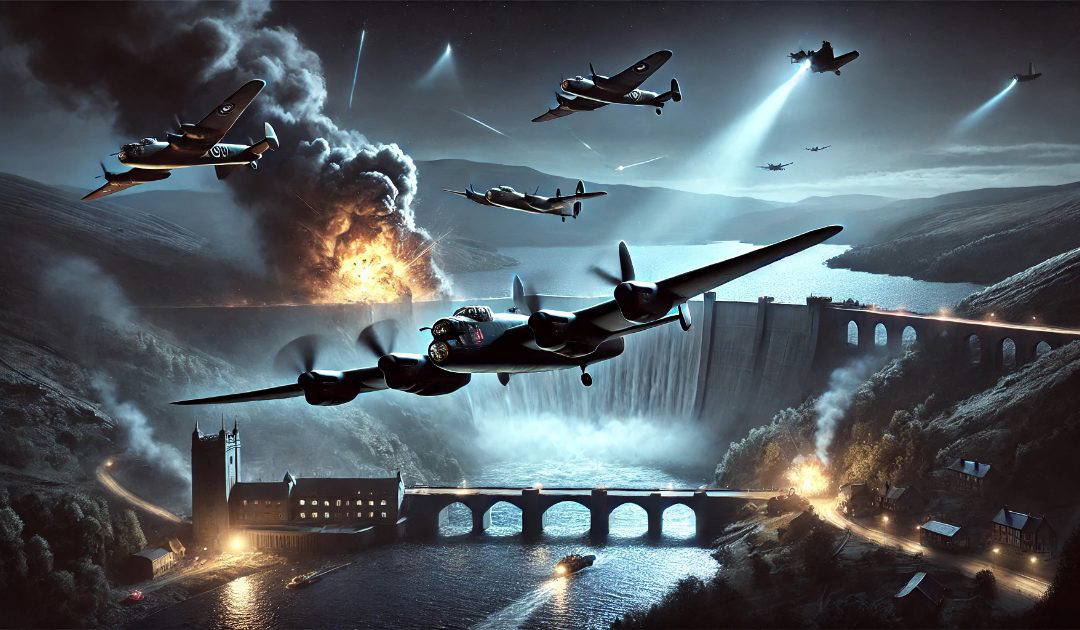The raid on German dams by 617 Squadron took place on the night of 16th/17th of May, 1943. In the annals of World War II history, few operations capture the imagination quite like the audacious raid on German dams by the Royal Air Force’s 617 Squadron. Known as Operation Chastise, this daring mission demonstrated a combination of innovative technology, strategic brilliance, and unmatched bravery.
During the height of World War II, the industrial heartlands of the Ruhr Valley in Germany were vital to the Nazi war effort. The region’s factories churned out weapons, munitions, and other critical war supplies. However, these industries heavily relied upon the water from the Ruhr, Eder, and Sorpe dams. Thus, these massive structures became critical targets.
The idea behind targeting the dams was simple yet devastating: break the dams, unleash floodwaters, and cripple the industrial capacity of the region. Furthermore, the destruction would cause widespread chaos, disrupting German production and morale.
The key to the operation’s success lay in the hands of Barnes Wallis, an engineer whose invention was set to revolutionise aerial warfare. Wallis developed the “bouncing bomb,” officially known as the Upkeep bomb. This cylindrical bomb was designed to skip over water like a stone before impacting its target, sinking, and detonating at a predetermined depth, causing a destructive shockwave.
The challenge lay in perfecting the precise mechanics of the bomb and ensuring it was deployed accurately. This required unprecedented levels of low-altitude flying, previously untried with such large bombs.
To execute this high-risk operation, a new squadron was formed. Led by Wing Commander Guy Gibson, 617 Squadron was composed of the RAF’s most skilled and experienced pilots and aircrew. Gibson, a seasoned pilot with a reputation for leadership, was tasked with preparing his men for what would be a perilous mission.
The squadron underwent intensive training, focusing on low-level night flying and practising bomb deployment techniques. Their Lancaster bombers were specially modified to carry the unique bouncing bombs.
On the evening of the 16th of May 1943, 19 Lancaster bombers took off from RAF Scampton, each tasked with targeting the dams. The raid was meticulously planned with navigational routes designed to avoid radar detection and enemy anti-aircraft fire.
The first target was the Möhne Dam. Led by Gibson himself, the bombers flew perilously low to evade detection and the intense anti-aircraft fire. The first few attempts failed, but persistence paid off when a bomb successfully breached the dam, sending millions of tonnes of water crashing down the valley.
The Eder Dam was next. Despite its remote location and formidable defences, the bombers managed to breach it after several attempts, adding to the chaos already unleashed by the Möhne breach.
The Sorpe Dam, however, proved more resilient. The bombers struggled with the challenging terrain and defences, and despite numerous attempts, the dam remained intact.
The immediate aftermath of the raid was a spectacular success. The breaches in the Möhne and Eder dams unleashed catastrophic floods, wiping out infrastructure, flooding factories, and causing significant disruption to the German war effort. The mission was hailed as a significant morale booster for the Allies. It demonstrated ingenuity and courage, reinforcing the belief in victory despite the challenges. However, the cost was high. Of the 133 aircrew who set out, 53 were lost, a testament to the mission’s perilous nature. The true impact of the raid on the German war effort remains debated, with repairs and countermeasures swiftly implemented by the enemy.
The legacy of 617 Squadron’s raid endures, etched into history as a symbol of bravery and innovation. The operation inspired numerous books, documentaries, and the 1955 film “The Dam Busters,” which immortalised the daring exploits of those involved. I have posted about my favourite films before. How could I forget the “The Dambusters”?

